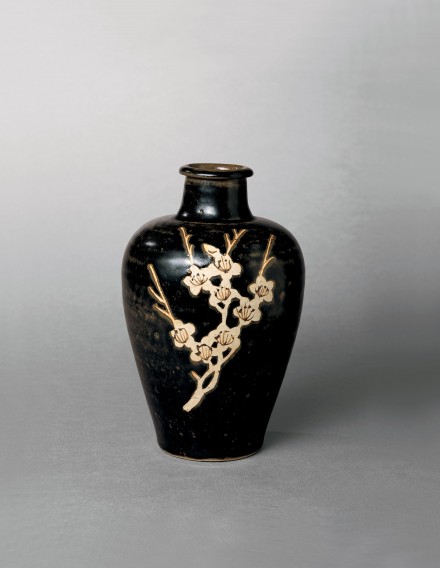J.J. Lally & Co., Oriental Art / New York City, New York
MenuPast Exhibition
Early Chinese Ceramics: An American Private Collection
March 28 - April 16, 2005

25.
A JIZHOU BROWN-GLAZED PRUNUS-DECORATED VASE (MEIPING)
Southern Song Dynasty (A.D. 1127–1279)
of shouldered form with a broad tapered neck and lipped rim, decorated around the sides with two flowering prunus sprigs, the blooms executed in wax-resist technique with brown-painted detailing, and the shoots swiftly carved through the very dark brown thick glaze, extending down to the foot and covering the underside of the base, the footrim left rough and unglazed showing the gray ware burnt slightly orange in the firing.
Height 7 5⁄8 inches (19.4 cm)
A vase of similar shape and design excavated in 1956 from a Jizhou kiln site at Yonghezhen, Ji’an, in Jiangxi province, is illustrated in Wenwu, 1975, No. 3, pl. 4, fig. 4, together with a pear-shaped vase with similar decoration from the same site and a vase of similar form with scattered five-petalled flowerheads from Nanchang; another vase of this type, also excavated in Jiangxi, is published in Wenwu, 1980, No. 2, p. 73, fig. 1.
Compare also the similar Jizhou meiping with prunus decoration, in the collection of the Palace Museum, Beijing, illustrated in Gugong Bowuyuan Cang Wenwu Zhenpin Quanji, Liang Song Ciqi (The Complete Collection of Treasures of the Palace Museum, Porcelain of the Song Dynasty), Vol. 33, Hong Kong 1996, p. 236, no. 217.
Other Jizhou vases of this shape decorated with prunus sprays are illustrated by Tregear, Song Ceramics, London, 1982, pl. 261, from the Barlow Collection, University of Sussex; by Ayers, Far Eastern Ceramics in the Victoria and Albert Museum, London, 1980, no. 110; by Valenstein, A Handbook of Chinese Ceramics, New York, 1989, pl. 115, in the Metropolitan Museum of Art; and in Oriental Ceramics: The World’s Great Collections, Vol. 9, Tokyo, 1981, no. 73, in the Freer Gallery of Art. A pear-shaped Jizhou vase with the same blossoming plum motif in the same distinctive technique is illustrated by Mowry in Hare’s Fur, Tortoiseshell and Partridge Feathers: Chinese Brown-and Black-Glazed Ceramics, 400–1400, Cambridge, 1996, no. 102, pp. 251–252, with a detailed description of the technique, followed by three larger meiping of the same form as the present example, differently decorated, ibid. nos. 103–105, pp. 253–258, all attributed to the kilns at Yonghe, Ji’an, Jiangxi province.
宋 吉州黑釉剔花梅瓶 高 19.4 厘米
25.
A JIZHOU BROWN-GLAZED PRUNUS-DECORATED VASE (MEIPING)
Southern Song Dynasty (A.D. 1127–1279)
Height 7 5⁄8 inches (19.4 cm)